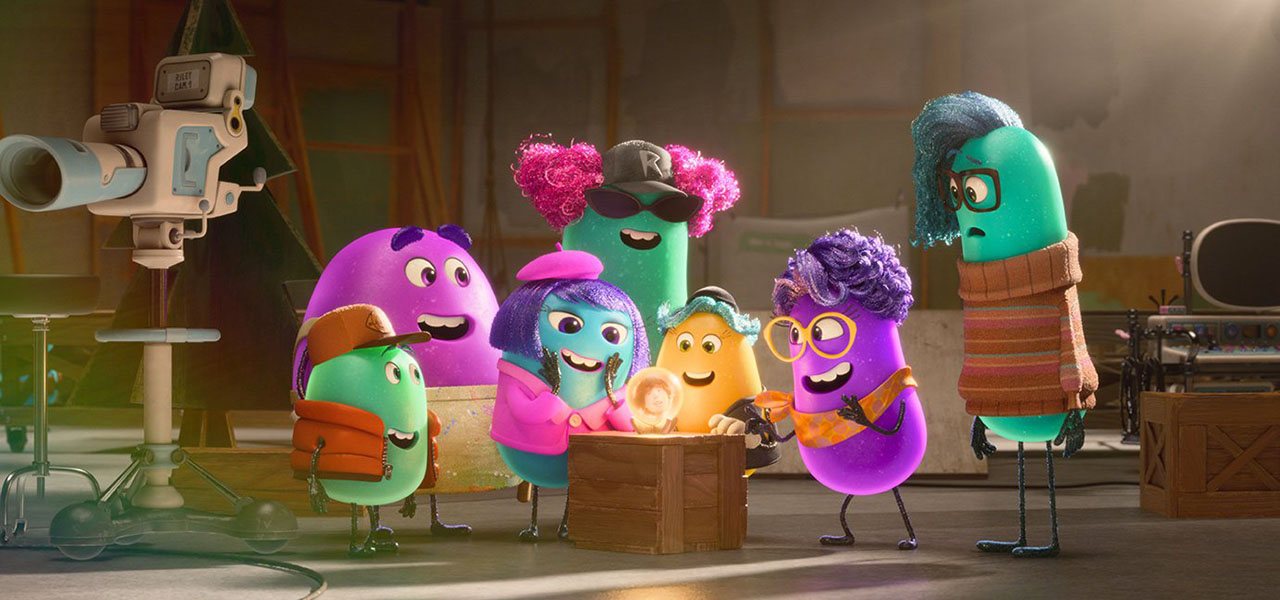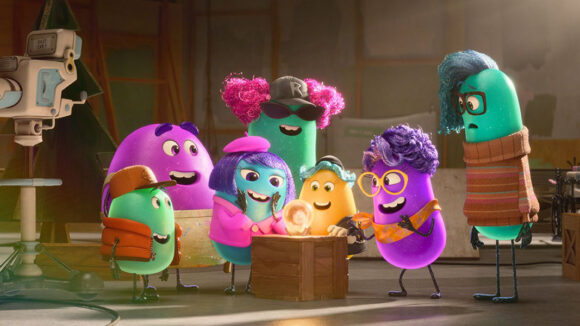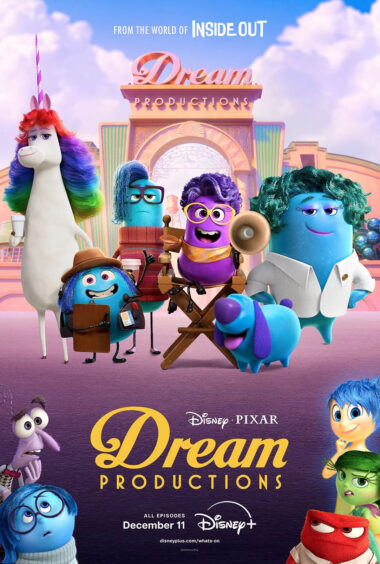

The Turbulent, Messy, And Creatively Radical Production Of Pixar’s New Series ‘Dream Productions’
Dream Productions, Pixar Animation Studios’ latest television series – derived from the hugely popular Inside Out movie franchise – releases today on Disney+. Billed as an ‘interquel’ – a spin-off slotting in between the 2015 and 2024 films – Dream Productions returns to the inner workings in the mind of troubled teen Riley Andersen and follows Riley’s ‘dream director’ Paula Persimmon (Paula Pell) who teams with daydream specialist Xeni (Richard Ayoade) in Riley’s dream-making studio to create Riley’s next big tween-dream.
In late October, Cartoon Brew attended a panel at the Fredrikstad Animation Fesitval on the making of Dream Productions, presented by Bill Wise, a longtime Pixar veteran and the show’s vfx supervisor. The show was the final project that Wise worked on at Pixar, and his 30-year career with the company ended last July. At Fredrikstad, he spoke candidly to the audience about his experience on the series.
“[The making of Dream Productions] is mostly a story about process and people,” said Wise. “Pixar has long had its own proprietary pipeline, and it does have some advantages, but we had to adapt for what we were tasked to do: a series of 140 minutes, seven episodes, with feature quality for a fraction of the price.”

Without revealing detailed statistics, Wise spoke in terms of labor weeks. “Over the last ten years, a Pixar movie typically had a budget between 18,500 and 22,500 labor weeks. For Dream Productions, we had an initial budget of 10,000 [weeks]. This was a grand experiment for Pixar, as we also had multiple directors working with our lead writer Mike Jones [who was our] showrunner. We knew from the very beginning it was going to be concurrently in production with Inside Out 2, which had been greenlit. And so our journey began.”
From early on, the team focused on compressing each department’s workload. “Our writing schedule was pretty aggressive,” Wise explained. “We had a nine-week writer’s room and four months of script development. And, to have a firm idea of our ending, we intended to have seven lock[ed] scripts — which is not standard at Pixar. Our production schedule looked very similar to that of a feature, but we knew that we were going to work on several episodes at the same time. This required more discipline, especially since we had to create one-and-a-half time as much footage time with half a feature budget.”
To achieve this goal, the Dream Productions teams reused assets from the first Inside Out and collaborated with Pixar’s feature pipeline which shared new assets that production staff were creating for Inside Out 2. “Historically, at Pixar, each film has its own ‘island,’ as we call it,” Wise explained. “That’s partially because, back in the day, each film brought something wildly different than the next, reinventing huge chunks of the pipeline. We did not want that instability, so without having the budget to develop new technologies for our show, we built boundaries around our version of the toolset. And within our team, we broke down barriers.”
To streamline operations, Wise and his teams combined departments, such as art and assets, and encouraged flexibility between departments, using dailies viewing sessions as a forum for director review, for all technical departments and shot work, in one room. “This happens also in features,” noted Wise, “but it tends to happen later in the process. We didn’t have the luxury of a feature film budget.”
When Dream Productions began in August 2021, planning and preparation allowed for efficient and flexible ways of cost-cutting. However, by October of that year, the production faced its first curveball. “I have to emphasize,” said Wise, “it was made very clear from the beginning that we were lower priority than features. [That applied to] pretty much everything, but especially staffing resources. As our production had just started, we were told that we would not be able to get our asset or animation supervisors due to staffing issues on Elemental and Lightyear. That resulted in an eight-month asset start delay.”
Despite these setbacks, the production proceeded. The art department — under the guidance of art director Bert Berry — crafted the world of Dream Productions and the headquarters studio inside Riley’s mind, while other members of the team dug in Pixar’s backlot to resurrect characters, backgrounds, and props from the first Inside Out. “All of these could not be reused as is,” said Wise, “but we still inherited quite a lot. And at the same time, we benefited from things that were being completely redone for Inside Out 2. Because one of the biggest innovations from this production was our shared Perforce server.”
At Pixar, each production typically has its own Perforce server running as a walled garden. But to cut costs, Dream Productions was moved entirely to Inside Out 2′s server, where a shared area was created to maintain the independence of each production. Wise said: “It did help us, as we were able to exchange a lot of assets and focus our meager resources on creating the assets that just Dream needed. Difficulties arose when it came to asset quality. The ones we created for both projects had to be Inside Out 2 quality. That’s what we were aiming for anyway, but we were trying to do it differently, with fewer iterations. As Inside Out 2′s team was working with a feature mindset, they expected us to be able to do between three to six iterations. We were on a one-two iterations ratio, and we were loving it. In truth, we got the better end of the deal. We were able to reuse human characters, ‘Core Emotions,’ and other very complex characters. But it ended up also causing a lot of grief, as we were drawn into ongoing discussions about how we could tweak this, or that. And we were already behind schedule.”
With tight deadlines in mind, Dream teams went on working together, as the departments were brought closer and closer together. “The good thing about having everybody in the same room,” said Wise, “is that everyone had an idea of what each sequence was going to be. Again, this was a huge cultural change for Pixar, where departments such as editing, layout, and animation are more territorial in the way they do things. Here, with the producer and director’s help, we managed to create a new workflow where all the production pods would be looking and talking about things all the time, and they rode along with the changes as they were happening.”
The new workflow allowed more autonomy for the individuals and more creativity, and resulted in the creation of complex shots relatively quickly, with fewer iterations.

Despite delays and a budget that grew by $10 million from the initial budget, things were still on the right track for Dream Productions. But in early 2023, news broke that Disney was eliminating 7,000 employees and Pixar was pivoting away from streaming. “As you can imagine,” Wise recalled, “this is a huge morale hit. Dream Productions hadn’t been announced, and we didn’t know if we were going to be canceled. And to top that, our first three ‘locked’ scripts received significant notes from the executives.”
For Wise, the upheaval appeared to invalidate the creative processes that had enabled Dream Productions. “The initial creative plan was not something Pixar could stomach,” said Wise. “It was too radical a change for how Pixar was used to working, and we were eventually going to have to adapt to that. Meanwhile, both Elio and Inside Out 2 ran into serious story trouble, and their whole crews were put on hiatus. That led to Dream Productions carrying a lot more studio costs than initially anticipated, and a budget increase that was now $17 million above the initial budget.”
The downturn led to a 20% cut in Dream’s production budget and a cut from seven to four episodes. “How did we navigate these last few months?” reflected Wise. “All I can say was that it was a battle fought day to day and week to week, by our courageous producer, associate producer, our director, and all the team managers. Even though our budget still fluctuated because Inside Out 2 eventually fired up its production and they wanted everyone in the studio on it.”
Dream Productions met its deadline of March 2024, with an enormous productivity increase. According to Wise, the production’s animation average increased by 200%, effects by 300%, and lighting by 321%. Despite these achievements, Pixar layoffs hit the Dream team hard as the studio refocused its priorities on feature films.
“It was yet another blow for our team,” concluded Wise, sadly. “A team which had dedicated so much energy to doing their best with the cards that we were dealt. And, to my knowledge, it looks like Pixar learned little from our experiment. Inside Out 2′s success will only reinforce a feeling that the old ways are still relevant, and siloed departments work better. I actually think that the core idea of Dream, which was to get everybody in the same room, look at shots together, and make [creative] calls together was a good way to go. It doesn’t mean that you resolve everything; it just means you talk about it. And in the end, it propelled our creativity.”
Besides Dream Productions, the show Win or Lose – an eight-episode series, billed as Pixar’s “first-ever original long-form animated series” – is scheduled for February 19, 2025. No other Pixar series have been announced beyond these projects, and the studio is now focused again on producing feature films.


